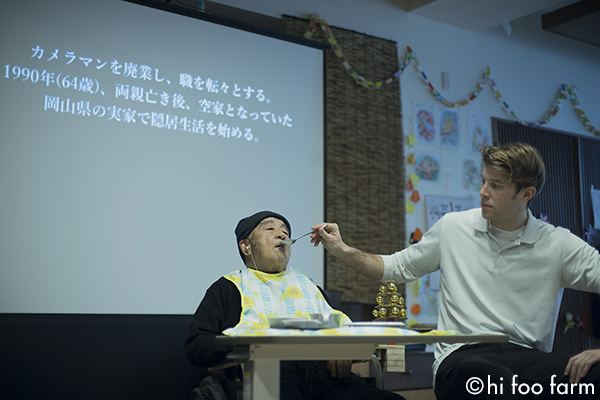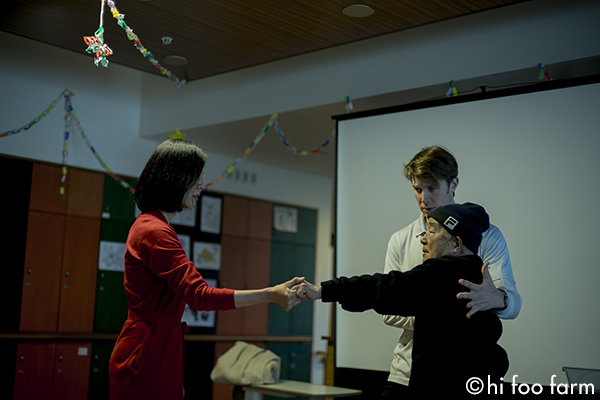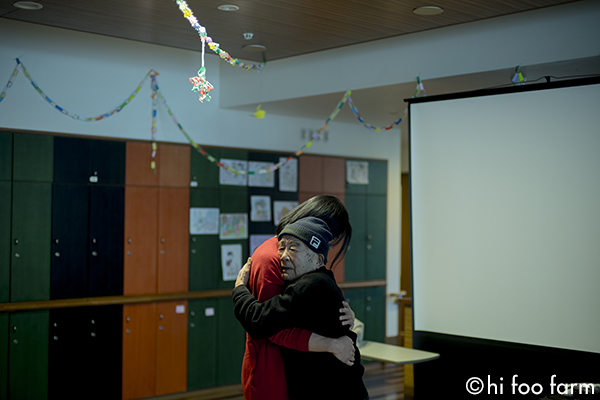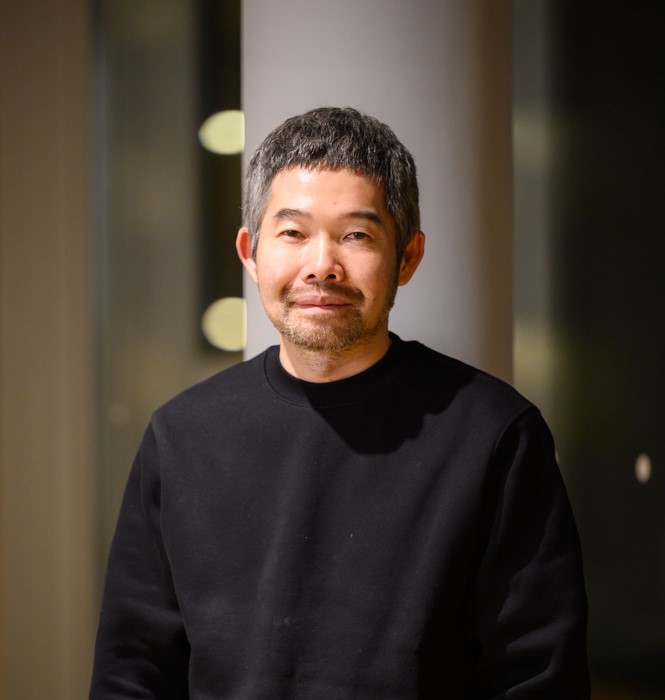


Cameraman no Hentai
(performance at Mimasaka Town, Okayama pref)
(Jan. 2018 at special-needs nursing home Keiryuso) Photo: hi foo farm
Data
:
Premiere: 2017
Cameraman no Hentai

Photo: Nanako Tomioka
Born in 1983, Sugawara is an actor and certified nursing care worker. A member of Oriza Hirata’s Seinendan Theater Company since 2010, Sugawara has pursued his career in theater while working as a caregiver at special care homes for the elderly. He relocated to the town of Wake in Okayama Prefecture in September of 2012 following the Great East Japan Earthquake, where he founded the theater unit OiBokkeShi and began the Aging and Theater Workshop program. With an 88-year-old man named Tadao Okada whom he met during a workshop as the lead actor, OiBokkeShi held its first performance in 2015; Theatre of Wandering: Night Never Gets Darker was set in the shopping arcade in front of Wake Station, Since then, Sugawara has been working under the concept of “bringing the knowledge of theater to caregiving, bringing the depth of caregiving knowledge to the theater studio.” The works that OiBokkeShi have presented up to now include High School for the Elderly (2015), Portable Toilet Theater (2018), and Re-Creation Ceremony (2023). In 2016, he shifted his base of operations to the town of Nagi, Okayama. He is involved in many invitational performances and projects outside his own company such as a collaboration with Saitama Gold Theater in 2018 as part of World Gold Theater to create Theatre of Wandering: Night Never Gets Darker – Urawa Version, and an OiBokkeShi and Mie Center for the Arts co-production of art projects such as Enjoying Care and Aging Brightly (since 2017). In 2018 he won the 69th Minister of Education, Culture, Sports, Science and Technology’s Art Encouragement Prize for New Artists (development of the arts).(Updated Jan.2025n 1983, Sugawara is an actor and certified nursing care worker. A member of Oriza Hirata’s Seinendan Theater Company since 2010, Sugawara has pursued his career in theater while working as a caregiver at special care homes for the elderly. He relocated to the town of Wake in Okayama Prefecture in September of 2012 following the Great East Japan Earthquake, where he founded the theater unit OiBokkeShi and began the Aging and Theater Workshop program. With an 88-year-old man named Tadao Okada whom he met during a workshop as the lead actor, OiBokkeShi held its first performance in 2015; Theatre of Wandering: Night Never Gets Darker was set in the shopping arcade in front of Wake Station, Since then, Sugawara has been working under the concept of “bringing the knowledge of theater to caregiving, bringing the depth of caregiving knowledge to the theater studio.” The works that OiBokkeShi have presented up to now include High School for the Elderly (2015), Portable Toilet Theater (2018), and Re-Creation Ceremony (2023). In 2016, he shifted his base of operations to the town of Nagi, Okayama. He is involved in many invitational performances and projects outside his own company such as a collaboration with Saitama Gold Theater in 2018 as part of World Gold Theater to create Theatre of Wandering: Night Never Gets Darker – Urawa Version, and an OiBokkeShi and Mie Center for the Arts co-production of art projects such as Enjoying Care and Aging Brightly (since 2017). In 2018 he won the 69th Minister of Education, Culture, Sports, Science and Technology’s Art Encouragement Prize for New Artists (development of the arts).(Updated in January 2025)
OiBokkeShi
https://oibokkeshi.net/



Cameraman no Hentai
(performance at Mimasaka Town, Okayama pref)
(Jan. 2018 at special-needs nursing home Keiryuso) Photo: hi foo farm
Data
:
Premiere: 2017
Act 1. The room of Masao Okaya, a nursing home resident. A stroke has paralyzed the right side of his body, and Okaya, who is no longer able to speak, spends his days in a wheelchair. A “bell” has been attached to the armrest of his wheelchair to signal others. Steven, an Australian caregiver, brings his dinner.
Subtitles on the screen in the background show Okaya’s life up to the present. Leaving Okayama for Tokyo; how he became a photographer; falling into debt due to failed stock market investments; his marriages to Setsu Tamura, a former geisha, and Asami Ikehara, an aspiring young actress, both ending in divorce; then return to his hometown to live in retirement.
Seeing that Okaya is not eating, Steven takes the spoon in his hand and tries to force him to eat, but he spits it out. Okaya rings the bell violently.
That signals that Okaya wants to take a picture. Steven picks up a single-lens reflex camera on the table beside him and Okaya directs him to take a picture each time he grunts “Uhn, uhn, uhn, uhn,” and he proceeds pressing the shutter aimed at various places around the room Okaya points to.
Act 2. An intense evening shower. Next to a sleeping Okaya appears a woman, dripping wet, who resembles Asami (a dual role also as Yoko). Okaya wakes up.
Subtitles display Okaya’s innermost thoughts, “You were the only beautiful one.” The woman replies, “You don’t understand anything. You only think of yourself…it was always that way.”
Okaya rings the bell violently Ding! Ding! Ding!
Steven rushes to him. It seems as if he is saying to take a picture of the woman. Steven has been keeping him company taking pictures for him, but this is the first time to take a picture of a person. She says he once took her picture a long time ago.
Steven follows Okaya’s directions, “Uhn, uhnn, uhn,” pushing his wheelchair here and there around the room to take pictures of the woman as she strikes one pose after another. The three grow increasing absorbed in it.
It becomes clear the woman is a former actress, that Okaya was quite a ladies’ man as a photographer and that Steven has come to Japan to search for his mother who abandoned him when he was three years old.
The woman puts on a record and she and Steven dance. As Okaya tries to get up from his wheelchair to take their picture he falls, the woman helps hold him up. Steven photographs the two of them holding each other.
The woman puts an old photograph in Steven’s hand and leaves. It’s a picture that Okaya took of Asami.
Act 3. Morning. A woman appears. The woman is Okaya’s daughter, Yoko, who moved there two weeks earlier. Steven tells Yoko that after her visit, Okaya began to eat well, but soon died receiving care from a new caregiver, a younger woman. Yoko says, “It’s just like him to fall for every passing girl.”
“I’m not any good at being a care worker,” says Steven. Yoko replies, “Thank you for taking pictures for him until the end,” and gives the camera to Steven.
Steven says he will return to Australia next month. He says, “I would really like to know what it feels like to be cared for,” and asks Yoko to feed him one of the doughnuts she brought as a gift.
Subtitles flow on the screen of the “Future lives” of the two. Steven returns to Australia and runs an internet shopping site with a friend. He takes landscape photos with that memento camera but dies an early death in a traffic accident at the age of 34. Yoko marries a junior high school teacher. She loses her husband when he dies. She develops dementia and reaches her final resting place at 98.
Steven points to a box by the side. A photo album comes out of it. Yoko is looking intently at the photographs. Ding! Ding! Ding! Steven rings the bell violently.
Photos the old man took are projected on the screen. They show rooms at the nursing home, scenery from the windows. Steven and Yoko together that evening. Then Okaya holding Yoko. Okaya looks at us from the photograph.
Related Tags